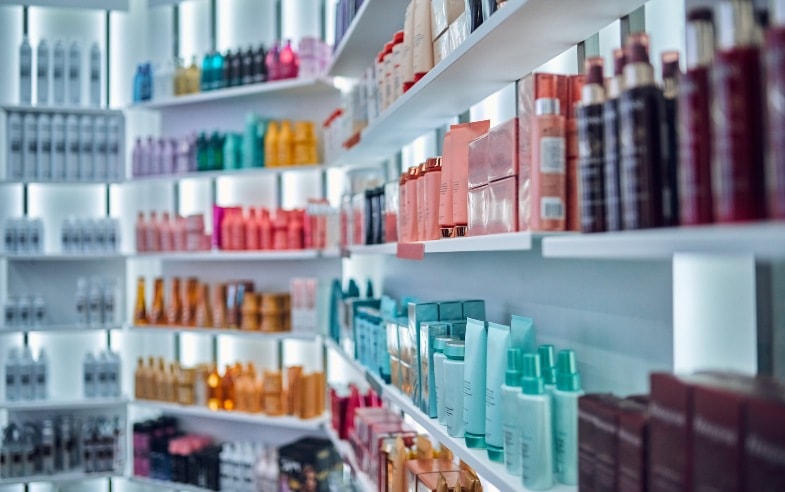Although the amazing services you provide your guests will be a major revenue stream for your salon, you can’t afford to forget about retail sales. A great salon retail strategy can help you meet your revenue goals, develop more points of contact with your guests, and take your beauty business to the next level.
In this article, we’ll go over the steps you need to take to crush your salon retail goals.
Calculating Your Optimal Salon Retail Revenue
Heath Smith, co-owner of Ruiz Salons in Austin, Texas knows a thing or two about maximizing a salon’s productivity for every square foot. A large part of that equation is leveraging your salon retail approach at every step of your guest’s journey.
Smith explains, “We have two revenue streams that are equally important—service and retail. When we look at revenue per square foot and efficiency, consider them both. Every part of your space should be producing income—including retail.”
The formula to determine the percentage of revenue that retail should be bringing into your business will look like:
Total Retail Sales ÷ Total Revenue (Service and Retail Sales) = Percent of Revenue
Smith notes that 12%-15% is the average percentage most salons calculate for retail revenue, but he prefers to be more aggressive in his salons.
“I like retail to be 20% or better. For over a decade, I’ve made sure that the revenue stream is as strong as possible, and it has been as high as 25%.”
Also, don’t forget to exclude gift certificates or memberships—anything paid for in advance that can skew the formula—from your calculations.
Rethink Your Inventory Process
To make sure you’re capturing the best goals for your retail strategy, it pays to spend some time with your inventory process first.
The first step is to properly categorize your inventory and services. As we noted, gift cards and other future purchases should be removed from your retail category. Smith further emphasizes the importance of creating categories for every item of retail inventory, such as:
- Styling products
- Shampoos
- Conditioners
- Skincare
- Equipment
- Jewelry
- Makeup
Smith explains:
“You need as much transparency in retail as possible. It starts with how you organize products the moment they come in the door. And everything that leaves your salon must show up on a ticket. If you give away a promo from a manufacturer for free, it should show up on the ticket at $0. And it will be in your inventory as costing $0 and selling for $0.”
Why does it matter? Inventory must be assessed correctly or it could affect your property taxes. Every state is different, but property taxes are assessed on the items you own. Your inventory must accurately reflect that, so your salon software and accounting software are in sync and you aren’t over or under-taxed.
While this process can seem overwhelming, salon software tools with built-in inventory management can effortlessly automate this process. SalonBiz allows you to track and edit your inventory on both desktop and mobile, creating one source of truth for your current inventory.
Make The Best Use Of Your Real-Life And Online Spaces To Boost Sales
While you may immediately think that adding more retail space can lead to higher sales, the most common mistake Smith actually sees salon owners make is devoting too much space to retail. He explains:
“Be conscious about the amount of square footage you’re allocating. It has to pay for itself. Every manufacturer has suggested square footage, but I like to keep it as small as I possibly can to still generate sales.”
Once you’ve determined how much space you’re allocating, make it visually pleasing. Stations cluttered with products aren’t going to entice clients to buy. Smith advises:
“There’s also no need to invent the wheel. Sure, products suspended from the ceiling look cool, but that’s not the way to get clients to buy. Retail giants like Sephora and Nordstrom have figured it out—look at what they’re doing and modify your space to do something similar.”
Once you have these two goals in mind, this is how to make the best use of your retail spaces—both in your salon and online.
1. Create disruptors
One way to get clients’ attention is with disruptors, like tables full of products they need to walk around to get to their stylist’s station. Smith explains:
“You have to interact with that table. These launchpads are great, but there’s still more you can do. Is there an opportunity to put candles in the changing room where guests put on robes? What about the restroom?”
If you’re intentional with the products you put in these areas, these “disrupters” can be effective selling spaces for salon retail.
2. Change up your displays
For regular clients who are in your salon every four to six weeks, retail can become predictable, causing them to lose interest. Smith says choosing products that reflect your brand, but that aren’t necessarily beauty items, helps combat retail boredom.
“Our brand is more classic and traditional, so we also carry several lines of jewelry and gifts that reflect that brand, I mix this all in so clients feel excited about looking at something new every time they come in.”
And once Smith has triggered that buying impulse, it’s much easier to sell the client beauty products as well.
3. Keep your stylists focused on retail
You can create the perfect retail environment, but if your stylists aren’t on board, you’re losing sales. Clients who purchase products are more loyal and have a connection to the salon, and stylists are the people who connect them. Smith explains:
“Getting the right products with the right information into the clients’ hands helps retain customers. We need to focus the service cycle on guests having an experience in our salons that includes retail.”
But in today’s tech-driven world, sometimes that service cycle gets cut short. If a guest checks out at the chair, it’s a missed opportunity to present products at the front desk. Instead, you have to figure out other creative ways to get products in front of guests. That usually comes down to your stylists.
For example, at Ruiz Salons, Smith educates his team with sales role play and ongoing coaching to keep retail front and center in guest conversations.
4. Build out your online salon retail sales
If your salon has online sales, let clients know they have a trusted source where they can replenish their products. Sell the right products on your website, with either delivery or curbside pickup options.
Smith suggests:
“Choose the right manufacturer to bring you into the equation if you want to do online sales. We know we can’t compete with the convenience of online sales, but we can be really compelling and amazing at delivering an experience in our space so we’re the first place they buy it, and after that, they can replenish on our site.”
But Smith says that’s still not enough. And for those products easily available online and in big box stores, like blow dryers and flatirons, Smith says salons will shift away from carrying them as there’s a push for more unique items that are not mass-produced.
“To stay competitive, owners must get creative in what they offer. If you have carefully curated products made specifically for your salon, there will be no comparison on Amazon. We need to do the homework and get the right products in our space that are interesting and priced well. Then get the team engaged, and engage our customers.”
Build Your Salon Retail Strategy
Keeping retail front and center in your salon takes daily focus, but it’s a huge part of your revenue stream, and there’s always room for growth. It all starts with the correct use of space, proper inventory, an online retail approach, and an understanding of how much revenue you should expect from retail.
Want to revolutionize your salon retail experience and boost revenue? Book a demo with SalonBiz today to see how our salon management software can help!





